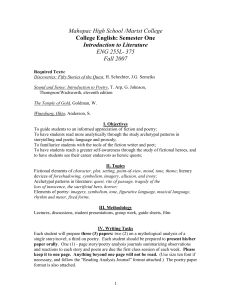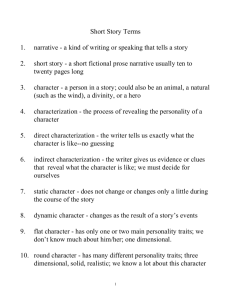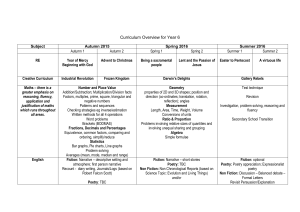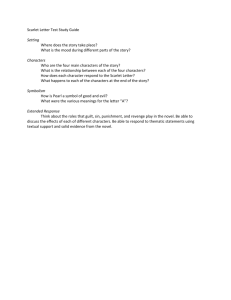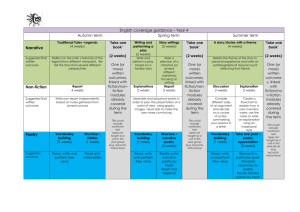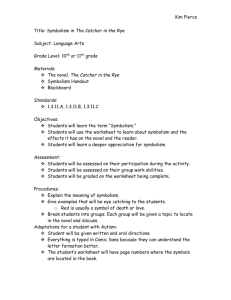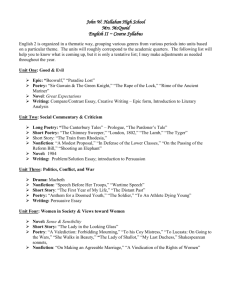Unit Map 10th 2012-13
advertisement
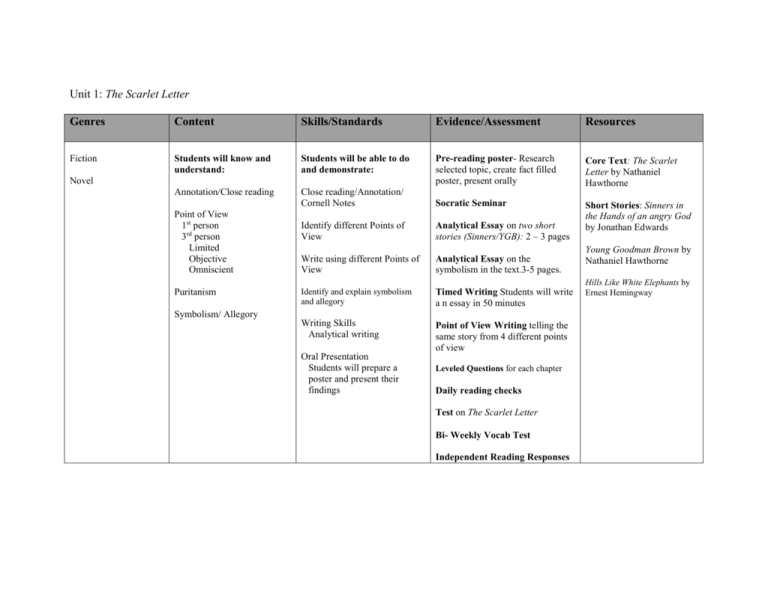
Unit 1: The Scarlet Letter Genres Content Skills/Standards Evidence/Assessment Resources Fiction Students will know and understand: Students will be able to do and demonstrate: Pre-reading poster- Research selected topic, create fact filled poster, present orally Core Text: The Scarlet Letter by Nathaniel Hawthorne Annotation/Close reading Close reading/Annotation/ Cornell Notes Socratic Seminar Identify different Points of View Analytical Essay on two short stories (Sinners/YGB): 2 – 3 pages Short Stories: Sinners in the Hands of an angry God by Jonathan Edwards Write using different Points of View Analytical Essay on the symbolism in the text.3-5 pages. Identify and explain symbolism and allegory Timed Writing Students will write a n essay in 50 minutes Writing Skills Analytical writing Point of View Writing telling the same story from 4 different points of view Novel Point of View 1st person 3rd person Limited Objective Omniscient Puritanism Symbolism/ Allegory Oral Presentation Students will prepare a poster and present their findings Leveled Questions for each chapter Daily reading checks Test on The Scarlet Letter Bi- Weekly Vocab Test Independent Reading Responses Young Goodman Brown by Nathaniel Hawthorne Hills Like White Elephants by Ernest Hemingway Unit 2 Literary Devices Genres Content Skills/Standards Evidence/Assessment Resources Short Stories Students will know and understand: Students will be able to do and demonstrate: Analysis of Author’s Purpose Cultural, social, and historical influence within literature (Irving, Lee, Miller, Wilson) Annotating and charting text Novel: To Kill a Mockingbird – Harper Lee Comprehension Questions on each text Poetry: The Raven – Edgar Allen Poe Summaries Nonfiction Fiction Poetry Drama Big Ideas: Otherness Prejudice Dreams/Visions Discrimination Reform Dignity The elderly Diction & Syntax Literary elements Mood Tone Symbolism Imagery Conflict Alliteration Character Connotation Denotation Diction Syntax Figurative Language Author’s Purpose Issues or themes that Use symbolism, setting, dialogue, and character to determine mood and tone Identify and understand the cultural, social, and historical influence from text Daily reading checks Non-fiction: Weekly Skills check Fiction: Short Stories Dr. Heidegger’s Experiment – Nathaniel Hawthorne Vocabulary Quiz Major writing assignments Interpret and apply inference skills to make meaning and understand text Analyze author’s purpose and evaluate effectiveness for different audience (includes fact or opinion, author’s point of view, tone, and use of persuasive devices) (Intro Exit tickets The Devil and Tom Walker – by Washington Irving The Bet – Anton Checkov Tusk, Tusk by David McKee ( for differentiation) Black Misery, by reflect the viewpoints of Americans of the time Awareness of ideas that dominate different cultures Social commentary (social issues within society) to Appeals: pathos) Analyze author’s use of literary elements and devices in relation to theme and/or message. Understand theme through identification of main ideas and supporting details. Make cause and effect connections within the text or between texts/media. Langston Hughes (for differentiation) Drama: Death of a Salesman – Arthur Miller Fences – August Wilson PPT presentations – Symbolism “The Devil and Tom Walker” Make inferences or predictions based on reading of texts and media. Content – “Fences” by August Wilson Prologue – what it teaches about theme, plot, characters Symbolism of the title Setting – time period, socio-political climate, place; and their impact on characters Introduction of characters by narration, other characters, dialogue, interpersonal relationships/response to crisis Readers’/audience’s earlier impression of main characters based on dialogue What is the source of conflict in the play (at the workplace, Skills - “Fences” by August Wilson 1. 2. 3. 4. 5. 6. 7. 8. 9. Predict plot from cues given in prologue Interpret symbols Identify similar symbols in environment (ex. Fence = prison, controlling relationships, curfews) Define character traits Form personal impression of characters Identify causes of conflict Find solution for the conflicts encountered Identify fences in the characters’ lives Identify writer’s intention, attitude, message Strategies in context (Plot, characterization, symbolism, diction, figurative Assessment Direct/Indirect Character analysis What is your first impression o the main character Troy? What do you like of dislike about him? Why? Discuss and write about how the familial relationships, parental expectations)? Dominant themed on the play dreams and expectations fences/barriers segregated sports role of women forgiveness language, etc.) Literary elements Character Diction Mood Syntax Tone Symbolism Conflict Figurative Language Write all the words/phrases that are associated with the symbol “fence” Predict what the plot of the play will be based on the message of the prologue Use the setting to help define the characters What is your first impression o the main character Troy? What do you like of dislike about him? Why? What statement does the playwright make about marriage by allowing Alberta to die? Rose’s and Troy’s marriage to break up? Does he applaud or oppose independence in women? How do Rose and Bonnie illustrate this? interaction among the characters helps the readers to get to know them. History & Literature Negro Baseball league Unit 3: Things Fall Apart Genres Content Skills/Standards Evidence/Assessment Resources Fiction Students will know and understand: Students will be able to do and demonstrate: Pre-reading poster- Research selected topic, create fact filled poster, present orally Things Fall Apart by Chinua Achebe Elements of characterization Identify and analyze the characteristics of culture in Things Fall Apart Novel Imperialism African (Igbo) Culture Gender roles Identify and analyze the character traits of Okonkwo in Things Fall Apart Writing Skills Analytic writing PPT Presentation Critical Analysis on the culture in Things Fall Apart: 2-3 pages Character Analysis on Things Fall Apart: 2 – 3 pages Dear Abby letter as one of the characters (character and critical analysis) Obituary for Okonkwo Daily reading checks Oral Presentation Students will prepare a poster and present their findings Test on Things Fall Apart Unit Test on Characterization Bi- Weekly Vocab Test Independent Reading Responses Unit 4: Poetry Genres Content Skills/Standards Evidence/Assessment Resources Poetry Students will know and understand: Students will be able to do and demonstrate: Poster- Research 6 Poetic Devices, define and provide examples, teach devices to class Variety of poems including, but not limited to: Poetic Devices SOAPSTone Analysis and write an essay based on the SOAPSTone Rhythm and Meter Forms of poetry Odes, sonnets, sestinas. spoken word Identify forms of poetry Analysis devices (Speaker, Occasion, Audience, Purpose, Subject, Tone) Writing Skills Analytic writing (poetry analysis) That poetry is written across all cultures in varying ways Oral Presentation Memorize and recite original poetry with an Poetry Explication Portfolio of original poems Oral presentation of original poems Poetry Analysis Essay on 1-2 Poems: 3-5 pages Unit Test on Poetic Devices, Forms and Analysis (SOAPSTone, TPCASST) Bi- Weekly Vocab Test Stop All the Clocks by W.H. Auden The History Teacher by Billy Collins Trees in the Garden by Stephen Crane Mother to Son by Langston Hughes Sonnet 29 by William Shakespeare A Barred Owl by Richard Wilbur emphasis on rhythm and meter Independent Reading Responses Unit 5: Othello Genres Content Skills/Standards Evidence/Assessment Resources Fiction Students will know and understand: Students will be able to do and demonstrate: Pre-reading poster- Research selected topic, create fact filled poster, present orally Othello by William Shakespeare Shakespeare’s background Identify Iambic Pentameter Drama/Shakespeare Written Analysis of each act Language of Shakespeare/Iambic Pentameter Writing Skills Analytic writing (Critical analysis of text/film) Characteristics of Shakespearean Plays Oral Presentation Students will memorize and recite a minimum of 20 lines Daily reading checks Students will prepare a poster and present their findings Memorization and recital of a minimum of 20 lines. Compare/Contrast Writing on Othello films and text: 3-5 pages Trial of Othello Tragic Hero/Character Flaws Memorization/ recitation techniques Explication and Analysis of a Sonnet Translate Shakespearean lines into a tweet Multiple Tests on Othello Bi- Weekly Vocab Test Independent Reading Responses Variety of Shakespearean Sonnets Film: Othello (1922) Othello (1995) O (2001) Unit 6: Narrative of the Life of Frederick Douglas Genres Content Skills/Standards Personal Narrative Students will know and understand: Students will be able to do and demonstrate: Evidence/Assessment Analysis of Author’s Purpose Slave Narrative Author’s Purpose Characteristics of Autobiography Recognizing rhetorical questions and using them effectively in persuasive writing Student will recognize literature as a record of human experience. To be able to analyze and describe tone and mood in literary writing Sentence variety Write sentences using a variety of structures Autobiography Nonfiction Fiction Poetry Big Ideas: Integrity Discovering the truth Courage Dreams/Visions Punctuation Rules Rhetorical Awareness Rhetorical Questions Tone Varying Sentence Structure Punctuation and Clarity Learn to use the following punctuation marks correctly: end marks, commas, semi-colons, apostrophes, quotation marks, and em-dashes Make a good outline that can help students state an Comprehension Questions on each chapter Summative Assessment: Personal Narrative – to share an important experience that includes a bad decision Reflective Narrative – to reflect on the impact of a change in your life Poem Analysis Presentation – to explore meaning Formative Assessment: Write Source student rubrics in Narrative Unit Journal entries reflecting personal viewpoints of the social issues discussed Narrative map Resources Timeline of the life of Frederick Douglass Frederick Douglass (Poem) by Robert Hayden Frederick Douglass and the War Against Slavery Narrative of the Life of Frederick Douglass, an American Slave Frederick Douglass, Leader Against Slavery by Patricia and Fredrick McKissack (for differentiation) Excerpts from: The Interesting Narrative of the Life of Olaudah Equiano The Confessions of Nat Turner Incidents in the Life of a How to Outline argument clearly and concisely Slave Girl Letter to Thomas Jefferson by Benjamin Banneker Unit 7: The Great Gatsby Genres Content Skills/Standards Evidence/Assessment Resources Fiction Students will know and understand: Students will be able to do and demonstrate: Pre-reading poster- Research selected topic, create fact filled poster, present orally The Great Gatsby by F. Scott Fitzgerald Symbolism and Allegory Identify and explain symbolism and allegory Novel Character traits Myth vs. Reality Concepts of the American Dream and Wealth Identify and explain their vision of the American Dream Writing Skills Persuasive essays Character Sketch (obituary) United States in the 1920s Persuasive writing techniques Identify and analyze relevant quotes from the text Oral Presentation Students will prepare a poster and present their findings Persuasive Essay on The American Dream: 2 – 3 pages Persuasive Essay on The Great Gatsby: 3 – 5 pages Daily reading checks Comprehension Questions for each chapter Written Analysis on each symbol in the novel Obituary for Jay Gatsby Socratic Seminar Test on The Great Gatsby Unit Test on Characterization Short Story: Hills Like White Elephants by Ernest Hemingway Article: Who Wants to Be a Millionaire: Changing Conceptions of the American Dream by Matthew Warshauer Bi- Weekly Vocab Test Independent Reading Responses Unit 8: Brave New World Genres Content Skills/Standards Evidence/Assessment Resources Science Fiction Students will know and understand: Students will be able to do and demonstrate: Analysis of Author’s Purpose Essay on Brave New World: 2 – 3 pages Brave New World by Aldous Huxley Author’s Purpose Elements of characterization: Character traits, round, flat, static, dynamic. Novel Characteristics of Science Fiction Characteristics of a dystopian novel that are prominently illustrated in Brave New World. How science and technology made the world better or worse Cite incidents in the novel to support Huxley’s theme: He who controls and uses knowledge wields power. Discuss the use of this novel as commentary on industrialization and science (i.e. How can conditioning develop a society?) Harrison Bergeron by Kurt Vonnegut Post-reading poster- Research selected topic, create fact filled poster, present orally Video Presentations Cloning Ivan Pavlov Conditioning – Twilight Zone : Number 12 Looks Like You Research Skills – (i.e. What is Cloning? Negative Impacts on Society? Conditioning? ) Comprehension Questions on each chapter Character Analysis Rubric Chapter Summaries Character Analysis Outline Discussion Skills Daily reading checks (Warm Up activity10 questions daily to confirm that students have read.) Character Analysis Prompts Writing Skills Analytic writing (character analysis) Oral Presentation Students will prepare posters and present their findings Dialectical Journal Entries Character Analysis Essay: 2-3 pages Character Trait Worksheet PPT Presentations Socratic Seminar Discuss how the author uses irony to critique and examine society Understand the use and purpose of allusion, especially to Shakespeare, in this novel. Expressive Listening, & Viewing: - Demonstrate reflection and insight while responding to texts through personal expression Reading, >Expressive Understands multiple perspectives Investigates connections between life and literature Considers cultural or historical significance Writing & Speaking >Expressive Articulates insightful connections between life and literature >Grammar/Language Analyze parts of speech as they relate to writing Edit for spelling and mechanics Extend effective use of phrases and clauses Student Performance Demonstrates the ability to read, to listen, and to view a variety of increasingly complex expressive print and media Reading, Listening, & Viewing: Test on Brave New World Wordly Wise Weekly Vocab Test ( book is segmented into units with comprehension practices. Aligns well with SAT. Independent Reading Responses *Summative Assessment: Personal Narrative – to share an important experience that includes a bad decision Reflective Narrative – to reflect on the impact of a change in your life Poem Analysis Presentation – to explore meaning Formative Assessment: Journal entries reflecting personal viewpoints of the social issues discussed Topic web · Narrative map Sensory detail chart >Student Performance Monitoring the adequacy of comprehension Making connections from text to text, self, and world Asking questions of themselves, the authors they encounter, and the information they process Making inferences during and after reading Distiguishing important ideas Synthesizing information >Grammar/Language Decoding vocabulary using bases and affixes. Using vocabulary strategies (context clues, resources) Discern the relationship of words in analogies [check alignment with SAT] > Genre Analyze the characteristics of literary genres and how the selections shape meaning. Relate ideas, styles, and themes within the movements. Understand influences in the movements. · Evaluate the literary merit and historical significance of works. · Making and supporting valid responses about the text through references to other works and authors · Comparing texts to show similarities or differences in themes, characters, or ideas
